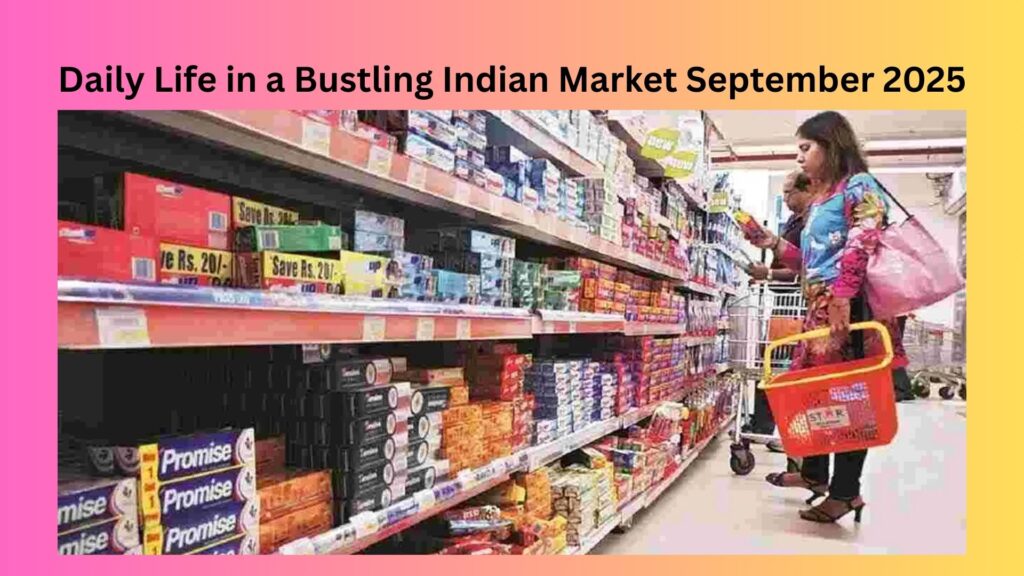When you step into an Indian market, especially in September 2025, it feels like diving headfirst into a living, breathing canvas of colors, sounds, and aromas. These markets aren’t just about shopping—they’re about culture, tradition, and the everyday pulse of life. Let’s explore what daily life in a bustling Indian market really looks like, and why these vibrant places continue to thrive in a modern, fast-paced world.

The Heartbeat of Indian Life
Markets in India have always been more than just trading hubs. They are the social heartbeat of communities. Whether you’re in Delhi’s Chandni Chowk, Jaipur’s Johari Bazaar, or a small-town haat, markets bring together people from all walks of life.
Morning Scenes: The Calm Before the Storm
Early mornings in Indian markets are surprisingly calm. Shopkeepers sweep their stalls, set up displays, and sip steaming cups of chai before the rush begins. You’ll see vegetable vendors neatly arranging piles of tomatoes, coriander, and okra while the aroma of freshly fried samosas drifts in the air.
The Midday Hustle
By noon, the energy explodes. Customers flood the narrow lanes, bargaining becomes louder, and honking scooters try to squeeze through the crowd. Hawkers call out catchy lines to grab attention, while women haggle with vendors like seasoned negotiators.
A Symphony of Sounds
One thing you can’t ignore is the soundscape. From the rhythmic clinking of steel utensils to the constant chatter of shoppers, every sound adds to the market’s personality. Street musicians sometimes add their tunes, making the entire place feel like a festival.
The Rainbow of Colors
Markets in India are nothing short of a rainbow. Bright fabrics, shiny jewelry, baskets of marigolds, and neon-colored plastic toys fill the scene. It’s like walking into a kaleidoscope where every turn offers a new burst of color.
The Power of Smells
Your nose gets a workout too. The fragrance of jasmine garlands mixes with the earthy smell of fresh produce and the spicy aroma of chaat stalls. If you follow your nose, you’ll probably end up at a food corner you can’t resist.
Food Stalls: A Market Within the Market
Food is a huge part of daily market life. In September 2025, the variety has only grown. From sizzling pakoras to momos, sugarcane juice, and kulfi sticks, the choices feel endless. Street food is not just affordable but also an experience you can’t separate from market life.
The Art of Bargaining
Bargaining is practically an art form in India. Locals and tourists alike try their hand at it. A vendor quotes double the price, the customer halves it, and eventually, they meet somewhere in the middle. It’s less about the price and more about the fun of the game.
Festivals and September Buzz
September in India often comes with the excitement of festivals like Ganesh Chaturthi and Navratri. Markets get decorated with lights, idols, ethnic wear, and festive sweets. Daily life becomes even busier, and the festive buzz adds a whole new layer of charm.
Meeting Point for Communities
Markets act as community spaces. Neighbors bump into each other, children run around munching on cotton candy, and elders sit sipping tea while discussing politics. It’s where social life thrives just as much as commerce.
Technology in the Market
By September 2025, technology has seeped into traditional markets too. Digital payments are now the norm. QR codes hang at tiny tea stalls, and UPI transfers replace cash almost everywhere. Still, the soul of the market remains unchanged.
Local Crafts and Small Businesses
Markets are lifelines for small businesses and artisans. From handwoven sarees to brass utensils, these stalls support local livelihoods. Despite malls and online shopping, these traditional markets refuse to fade because they offer authenticity and a personal touch.
Tourists in the Mix
For tourists, markets are like treasure hunts. They come searching for souvenirs, spices, handicrafts, or simply to soak in the chaos. Guides often recommend markets as the best way to experience the “real India.”
The Struggle Behind the Scenes
Life in the market isn’t all glamour. Vendors work long hours, deal with weather changes, and sometimes barely make ends meet. Yet, their resilience keeps the market alive. Their stories are woven into the daily rhythm of the bazaar.

The Evening Glow
As the day winds down, the market transforms. Lamps and fairy lights brighten up stalls, the crowd shifts to food vendors, and the chaos settles into a softer hum. It’s almost like the market takes a deep breath after a long day.
Why Markets Still Matter in 2025
Even with online shopping taking over the world, Indian markets remain timeless. They offer something no app can—human connection, sensory overload, and a chance to be part of a living tradition.
Conclusion
Daily life in a bustling Indian market in September 2025 is a celebration of tradition, chaos, and community. It’s where old meets new, where bargaining is as important as buying, and where every visit feels like stepping into a mini festival. Markets aren’t just about commerce—they’re about culture, connection, and the essence of Indian life. So, the next time you find yourself in one, slow down, look around, and soak it all in—you’ll walk away with much more than just shopping bags.
What makes Indian markets different from malls?
Indian markets are vibrant, chaotic, and deeply cultural, offering personal interactions and unique experiences that malls can’t replicate.
Why is September a busy month in Indian markets?
Because of festivals like Ganesh Chaturthi and Navratri, people shop for clothes, decorations, sweets, and gifts, making markets extra lively.
How has technology changed daily market life in India?
Digital payments like UPI and QR codes have made transactions faster and easier, though the traditional feel of markets remains intact.
What role do food stalls play in Indian markets?
Food stalls are central—they keep shoppers fueled, attract crowds, and showcase the local street food culture.
Do Indian markets still attract tourists in 2025?
Yes, tourists love markets for their authenticity, colorful atmosphere, and affordable souvenirs that reflect Indian culture.